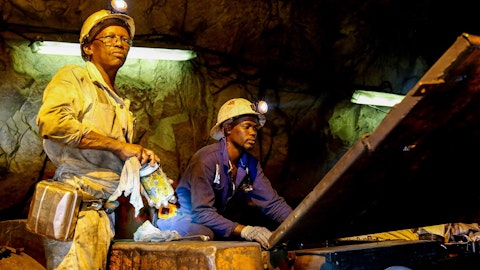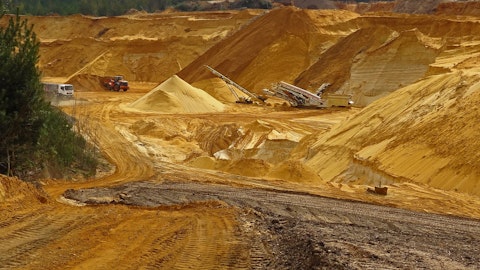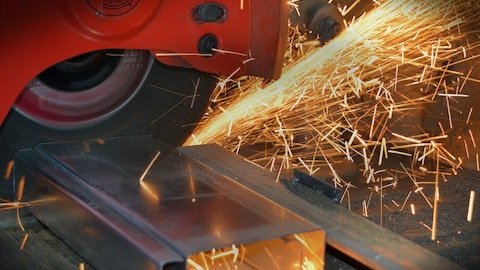The large gap between the net loss for Q4 2023 and the cash used in operating activities for the same period last year is due to a change in working capital, including an increase in accounts payable and accrued liabilities. Free cash flow for the last quarter of 2023 was negative $15.6 million compared to negative $20 million in the last quarter of 2022. Regarding our balance sheet, as at December 31, 2023, we closed the year with a cash balance of $6.8 million and held no debt. We believe that our cash on hand, along with the undrawn $25 million unsecured credit facility just now extended through August 2025 with an affiliate of Allseas and the new $20 million unsecured credit facility provided by Gerard Barron and ERAS Capital LLC, will be sufficient to meet our working capital and capital expenditure requirements for at least the next 12 months from today.
The right of use asset, the new line item here you see for $5.7 million in our balance sheet as at December 31, 2023, represents the net carrying value of the exclusive right to use the Hidden Gem in support of the development of the Project Zero offshore nodule collection system. In consideration for the exclusivity, we issued 4.15 million common shares to Allseas in August of 2023 as previously disclosed. On February 21, 2023, NORI entered into an investment agreement with low-carbon royalties to finance low-carbon emitting, energy production, and technologies in support of the energy transition. The value of the investment of $8.4 million as of December 31, 2023, represents the company’s shareholding in low carbon royalties, net of equity accounted loss for the year.
As part of this agreement, NORI contributed a 2% gross overriding royalty on its future revenue stream to low carbon royalties, and there is also a right potentially through south funding option, to buy back three-quarters of that royalty over time. And the right to the royalty payments was heavily discounted, reflecting the current stage of the project valued at $14 million and recorded in the first quarter of 2023 as a gain on disposition. Now, in connection with the preparation of the 2023 year on financial statements and some new information from the technical team of the company’s auditors, the company reevaluated accounting for this transaction and concluded that the sale of future revenue falls within the scope of ASC 470 and restated the offsetting entry to the proceeds as it received from low carbon royalties as a royalty liability.
This is a non-core and non-cash item and the impact of this restatement is described in detail in the company’s Note 22 of our annual report on Form 10-K. It is also described in the 8-K that came along with our press release filed post close today. I will now turn it back over to Gerard for some closing remarks and then we’ll get to Q&A.
Gerard Barron: Thank you, Craig. And as I said at the beginning, the time is now for this new industry. With our own research vessel back in port and the heaviest offshore pre-production spending in our rearview, our team’s attention is now focused on analyzing the copious amounts of environmental data and putting together an application for an exploitation contract for the NORI area, expected to be submitted following the July 2024 ISA session. And after seeing the initial results following the conclusion of our latest environmental campaign, I’m confident there are no showstoppers and we’re looking forward to continuing the release of all this data with stakeholders around the world. In the meantime, our executive team will continue the work of securing strategic partnerships and this is certainly where I’ll be devoting nearly all of my time in the coming weeks.
I would like to extend my sincere thanks to the TMC team, including our partners, our contractors, and of course our sponsoring states, and thanks to everyone who tuned in to our call today and for your attention. With that, I would like to hand it back to the operator for Q&A.
Operator: [Operator Instructions]
Craig Shesky: As we are waiting for that to compile, we are going to take a question from the web chat. Milo Amundsen has asked, is the 6% of share price on NORI assets or all assets. What percentage is it of all assets? It’s a good question. Look, we’ve always laid out what the valuation is based on NORI-D, which is our most advanced project, on which we are spending close to $500 million already on that project to bring it to where it is now and being able to leverage that investment is something that’s really starting to bear fruit now that the geopolitical tailwinds are blowing much stronger. NORI-D represents roughly 22% of the total estimated resource across NORI and TOML. Now, we did estimate when we went public that the full field net present value, if extrapolating the same assumptions from NORI-D, would be $31 billion of net present value.
But again, we like just focusing on the $6.8 billion as calculated with AMC consultants in the NORI-D initial assessment as their valuation guidepost. And our market cap represents roughly 6% of the updated value of that NORI-D initial assessment if you just use current metal prices, roughly $8 billion. So, to answer your question, it’s focused really just on NORI-D recognizing that there’s significant upside from the other 78% of our total estimated resource.
Operator: Thank you. And I show — we have a question on the phone line, and our question from the phone line comes from the line of Dmitry Silversteyn from Water Tower Research. Please go ahead.
Dmitry Silversteyn: Good afternoon. Thank you for taking my call. Just wanted to get maybe a little bit more detail. What were the main elements that resulted in the modest extension of the time to offshore production into the first quarter of 2026 versus the original date, which I think was given out as the fourth quarter of 2025?
Gerard Barron: Yeah. Hi, Dmitry. Look, there’s one driving reason, and that is moving the production number of that boat from 1.3 million tons to 3 million tons. And it was a decision that we had to take at the time. But of course, the economics are so much better when we can be handling the bigger production capacity. But what that requires is an upgrade. It requires us to make a couple of modifications for material handling. It required a slightly different Riser configuration, all of which has been managed by Allseas. And so that put a little bit of a dampener in the supply chain, and that’s what resulted in that later time frame.
Dmitry Silversteyn: Understood. And then if I can follow up on the March meetings that are going on right now with ISA. As you look at what will come out of it on the other end, what would be sort of the likely outcome that you’re looking for that you would interpret as good news versus, let’s say, disappointing outcome?
Gerard Barron: Look, this is the first time that a consolidated text has ever been presented to the council, and so it’s a really important milestone. And what we are looking out of this session is continued progress. And that’s what we’re seeing. It was a productive week last week. This week we expect to see the same. And that is just making progress towards further refining that consolidated text. And what we are also noting is that there is a lot of intercessional work continuing to be done by the member states, and that is increasing. And we expect that the period between the end of the March session and the beginning of the July session is when we are going to see a lot of those loose ends tidied up. And so, as for bad news, look, we haven’t seen any.
You always see a bit of noise around at this time, of course. And, but fundamentally, the noise is very different to the reality, and of what’s happening. You have 168 members who are working earnestly to put in place regulations because the one thing that everyone agrees is that regulating this industry is the best way of protecting the ocean environment. And so that’s what people are doing. And of course, we are very close to those regulations because we’re going to need to operate under them and we are not seeing anything that’s keeping us up at night.
Dmitry Silversteyn: Got it. Got it. That’s helpful. And then final question, if I may. The cash on hand and the liquidity that you have access to, typically you talk about lasting that for the next 12 months or something like that. I didn’t hear that statement on this call. So how do you see your liquidity position right now? And how urgently is the need to find a strategic partner, let’s say in 2024?
Craig Shesky: Sorry, Gerard, I can go first if you don’t mind. Just quickly on that, Dmitry, I did say that. And we did include in our press release that. Yes, we do believe that cash on hand plus these credit facilities, totaling $45 million is sufficient to meet our working capital and CapEx requirements for at least the next 12 months. Keep in mind too, the last number that we provided which I still think is a good guy post, was $35 million to $45 million of additional cash needed to launch our application. And I think what you should keep in mind is while we continue to get many inbound proposals for financing, we have our three largest shareholders who care very much about minimizing dilution. In fact, if you look at our total shareholder base, in excess of 50% of TMC shares are held either by insiders or affiliates.
So there’s very much a desire internally to do the right deal. And that’s why all of our focus is on the strategic side right now. And I think the confidence provided by not only the extension of the Allseas credit facility but the new credit facility from Gerard and Andrei, I think it just shows the confidence in those potential options.
Dmitry Silversteyn: Okay. Okay. Thank you.
Gerard Barron: Yeah. The easiest thing to do is to print equity. And — but as Craig said, we really do care about that equity stack because that’s where we care about our shareholders. We care about our employees, who, of course, are incentivized by the equity. And we have a very direct insight into, obviously, how those negotiations are going with interested parties. And we think this is the right course for the benefit of all shareholders.
Dmitry Silversteyn: Fair enough. Thank you, Gerard.
Gerard Barron: Thanks, Dimitry.
Operator: Thank you. And I show our next question comes from the line of Matthew O’Keefe from Cantor Fitzgerald. Please go ahead.
Matthew O’Keefe: Yeah. Thanks for taking my question. Just wanted to touch on the — if you could touch on the timing and maybe some of the scope of the upcoming feasibility study. Is that — that’s still on track for kind of mid-year? And maybe you could discuss a little bit about how it’s going to differ from the one in hand?
Gerard Barron: Sure. Do you want me to take that, Craig?
Craig Shesky: Sure. Happy to add color on it, too.
Gerard Barron: Yeah. Look, it’ll be a pre-feas that is going to be completed by mid-year. And of course, normally when you move from pre-feas to feas, it’s to do with tightening up the cost scope, and certainty around the budget. And it normally has to do know, large capital expenditure. Now, of course, we already have our first production asset. It’s the Hidden Gem. It’s owned by Allseas, and it’s the vessel that we use for the collector test. And we are working earnestly with our onshore partner at the moment that’s Pacific Metals up in Japan, who have an existing purpose-built nickel processing plant which we are able to tap directly into. And so that pre-feas is going to be really significant to just answer many of the technical issues and support our application. That’s the main purpose of it because we have a good insight into how those numbers are looking.
Matthew O’Keefe: Okay. Thanks. So will we get a sense from it as investors and analysts, sort of what the — I mean you’ll be paying PAMCO, you’ll be paying Allseas to collect the nodules, PAMCO to process them. Will that kind of detail be available in that and because in my model, it shows some fairly robust potential for some fairly robust economics?
Gerard Barron: Absolutely.
Craig Shesky: Yeah, look, certainly, Matt, yes. We would anticipate that. As the pre-feasibility is coming out and we are preparing for the application, there’s going to be a point where we’re going to be able to provide guidance to the market and a viewpoint of what to expect from project economics, especially now that we’re talking about a larger initial production system. So, absolutely. We know, frankly, we’ve had a lot of investors who have been waiting for that, and we want to make sure that we dot all the I’s and cross the T’s before we can release that. But, yeah, rest assured it’s coming. And we agree with you, we believe the economics are going to be robust.
Matthew O’Keefe: Okay. No, that’s great. Thanks. Looking good so far. Appreciate it. Thank you.
Gerard Barron: Thanks, Matt.
Operator: Thank you. And I show, our next question comes from the line of Vasu Patel from Patel Holdings LLC. Please go ahead.
Vasu Patel: Hi. So one of the questions I have is for the application for the ISA that we are submitting for NORI-D. As said in the past, there’s going to be costs attached to it. Is there approximate amount value to what the costs are? And will they be covered from the current cash assets, or do any of the credit facilities have to be tapped into?
Craig Shesky: Yeah. Look, I mean, the application itself, you’re in the ballpark of the million dollar fee for the application, but the real cost of the application is all of the work that goes into analyzing and collating the data and putting forth document of many, many hundreds of pages. We’ve already finished now, our sort of offshore campaign following one year on from the collection test. And a lot of that information is now being analyzed. There is going to be a key tenet of the environmental impact statement. We’re also talking about the pre-feasibility study that Gerard and I just mentioned. So the amount that we said, $35 million and $45 million of incremental funding, which does not include any tapping of our credit facilities, that is still a good number to keep in mind for what it’s going to take to get the application over the line.
So, yes, there is more work to be done and it’ll cost some money, but we feel now very, very good about the liquidity options at our disposal.
Vasu Patel: Got it. And this question really refers to future mining around 2026. As of right now, there’s one vessel. There’s a Hidden Gem vessel. But looking forward, how will production be ramped up once the application for exploitation is approved?
Gerard Barron: Good question. One of the things we’ve established is that processing our nodules can happen through rotary kiln electric furnace. And what we know is that there are hundreds of those lines that have been built in China, in Japan, and more recently in Indonesia, and they’ve been built to process nickel laterite ore. And so it’s a win-win. That industry has the capacity to take all of the production that will come off the NORI-D block and more into parties that we are currently in talks with. So we do not see the need to have to go and spend money building processing plants to handle the scale-up for the first phase and think of processing in two steps. One of it is known as the Pyrometallurgical process, and the other is the Hydrometallurgical process.



